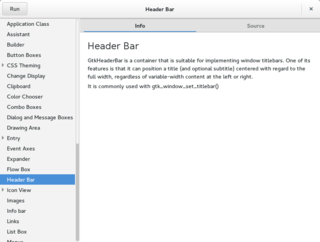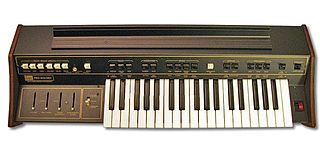
A barcode is an optical, machine-readable representation of data; the data usually describes something about the object that carries the barcode. Traditional barcodes systematically represent data by varying the widths and spacings of parallel lines, and may be referred to as linear or one-dimensional (1D). Later, two-dimensional (2D) variants were developed, using rectangles, dots, hexagons and other geometric patterns, called matrix codes or 2D barcodes, although they do not use bars as such. Initially, barcodes were only scanned by special optical scanners called barcode readers. Later application software became available for devices that could read images, such as smartphones with cameras.
In human–computer interaction and user interface design, cut, copy and paste are related commands that offer an interprocess communication technique for transferring data through a computer's user interface. The cut command removes the selected data from its original position, while the copy command creates a duplicate; in both cases the selected data is kept in a temporary storage device called the clipboard. The data in the clipboard is later inserted in the position where the paste command is issued. The data is available to any application supporting the feature, thus allowing easy data transfer between applications.

A bar code reader is an electronic device that can read and output printed barcodes to a computer. Like a flatbed scanner, it consists of a light source, a lens and a light sensor translating for optical impulses into electrical signals.Additionally, nearly all barcode readers contain decoder circuitry analyzing the bar code's image data provided by the sensor and sending the barcode's content to the scanner's output port.
Optical mark recognition is the process of capturing human-marked data from document forms such as surveys and tests. They are used to read questionnaires, multiple choice examination paper in the form of lines or shady areas.

PDF417 is a stacked linear barcode symbol format used in a variety of applications; primarily transport, identification cards, and inventory management. PDF stands for Portable Data File. The 417 signifies that each pattern in the code consists of bars and spaces, and that each pattern is 17 units long. The PDF417 symbology was invented by Dr. Ynjiun P. Wang at Symbol Technologies in 1991. It is ISO standard 15438.
Autocomplete, or word completion, is a feature in which an application predicts the rest of a word a user is typing. In graphical user interfaces, users can typically press the tab key to accept a suggestion or the down arrow key to accept one of several.

A control element in a graphical user interface is an element of interaction, such as a button or a scroll bar. Controls are software components that a computer user interacts with through direct manipulation to read or edit information about an application. User interface libraries such as Windows Presentation Foundation, GTK+, and Cocoa, contain a collection of controls and the logic to render these.

The ARP Pro Soloist was one of the first commercially successful preset synthesizers. Introduced by ARP Instruments, Inc. in 1972, it replaced the similar ARP Soloist (1970-1971) in the company's lineup of portable performance instruments.
Many people with severe physical or cognitive impairment use one or more switches to access computers. A switch is an assistive technology device that replaces the need to use a computer keyboard or a mouse.

Speech-generating devices (SGDs), also known as voice output communication aids, are electronic augmentative and alternative communication (AAC) systems used to supplement or replace speech or writing for individuals with severe speech impairments, enabling them to verbally communicate. SGDs are important for people who have limited means of interacting verbally, as they allow individuals to become active participants in communication interactions. They are particularly helpful for patients suffering from amyotrophic lateral sclerosis (ALS) but recently have been used for children with predicted speech deficiencies.
The PASCAL Photocoagulator is an integrated semi-automatic pattern scan laser photocoagulation system designed to treat ocular diseases using a single shot or predetermined pattern array. The device is for ophthalmologists, particularly those that focus in vitreo-retinal surgery, a type of eye surgery. It was developed by OptiMedica, an ophthalmic medical device company located in Silicon Valley.
Tangible symbols are a type of augmentative and alternative communication (AAC) that uses objects or pictures that share a perceptual relationship with the items they represent as symbols. A tangible symbol's relation to the item it represents is perceptually obvious and concrete - the visual or tactile properties of the symbol resemble the intended item. Tangible Symbols can easily be manipulated and are most strongly associated with the sense of touch.These symbols can be used by individuals who are not able to communicate using speech or other abstract symbol systems, such as sign language. However, for those who have the ability to communicate using speech, learning to use tangible symbols does not hinder further developing acquisition of natural speech and/or language development, and may even facilitate it.
The International Society for Augmentative and Alternative Communication (ISAAC) was founded in May 1983 in East Lansing, Michigan, United States. Its stated purpose is to improve the communication abilities and quality of life of individuals with complex communication needs who use augmentative and alternative communication (AAC). ISAAC provides information about AAC services, policies and activities around the world thorough various publications and their website. The society publishes a journal and various other publications, organizes biennial conferences, promotes research on AAC use and AAC development as well as implements various projects.
Partner-assisted scanning or listener-assisted scanning is an augmentative and alternative communication technique used to enable a person with severe speech impairments to communicate. The approach is used with individuals who, due to sickness or disability, have severe motor impairments and good memory and attention skills. It is used as an alternative to direct access to symbols, pictures, or speech generating devices when these are not used.
Semantic compaction, (Minspeak), conceptually described as polysemic (multi-meaning) iconic encoding, is one of the three ways to represent language in Augmentative and alternative communication (AAC). It is a system utilized in AAC devices in which sequences of icons are combined in order to form a word or a phrase. The goal is to increase independent communication in individuals who cannot use speech. Minspeak is the only patented system for Semantic Compaction and is based on multi-meaning icons that code vocabulary in short sequences determined by rule-driven patterns. Minspeak has been used with both children and adults with various disabilities, including cerebral palsy, motor speech disorders, developmental disabilities, autism spectrum disorder, and adult onset disabilities such as Amyotrophic Lateral Sclerosis (ALS).

Lightwriters are a type of speech-generating device.
The picture exchange communication system (PECS) is a form of augmentative and alternative communication produced by Pyramid Educational Consultants, Inc. While the system is commonly used as a communication aid for children with autism spectrum disorder (ASD), it has been used with a wide variety of learners, from preschoolers to adults, who have various communicative, cognitive, and physical impairments, including cerebral palsy, blindness, and deafness. PECS has been the subject of much academic research, with currently over 85 PECS-related publications.












